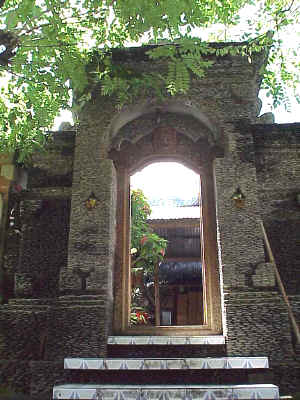The Home
A quick glance at the various basic architectural elements in Bali reveals a lot about the lifestyle of the Balinese. Temple gates and shrines are very elaborate and intricately worked, and at the same time harmoniously positioned and symmetrical. The village is an example of communal architecture at its best with large open pavilions enormous village commons and kul kul. All reflect the “one big family” concepts of Balinese village life.
Inside the compound are raised pavilions facing inwards into a courtyard where a pagoda or large tree provides shade from the midday sun. The ground is swept every morning as with most places inhabited or used for business in Bail. A compound is usually dotted with flowers shrubs, and bushes. The house of the three higher castes are invariably made up of a number of interlocking courtyards which lead through to the family temple in the north-east corner where daily offerings are made. Every family temple in Bali has an anniversary, a closed affair when the family plays homage to their ancestors and to Sang Hyang Widi Wasa, the supreme God.
The family compound awakens to life at the first sign of dawn. The women with a tray in hand, walk out to buy some leaf packets of cakes and sweetmeats which with coffee provide the morning meal. The entire day’s supply of rice is put on to boil. As the sun tops the palms the family members take their morning wash in turn at the local spring or river.
Before the heat of the days arrives everybody is out of the compound going about his or her daily routine. The wives go shopping in the local market or store for meat and vegetables, while the men labor in the fields or work in one of the village centers. The school days for the children start at 7. Most Balinese have their first rice meal late in the morning. The middle of the day is a time for resting in the family compound or Bale Banjar, or talking with friends under the shade of the village banyan tree. As the afternoon cools, village activity picks up. Men gather clutching their prized fighting chickens in tight groups outside their favorite warung (fool stall), or they squat in front of the temple to admire the passing parade of people going to or from their afternoon bath. Every village has a “Club” for those who like to enjoy the sunset in the company of a glass of palm wine. The last meal of the day is taken shortly after sunset. As the gentle harmonies of the gamelan practicing waft through the thick night air, those who are too tired to talk away the hours in the village haunts retire to their respective homes.
Within the walls of the family compound young Balinese receive all their religious training. From generation to generation the complex code of the Balinese order and etiquette is passed on. In an atmosphere of harmony and content, dissent never raises its ugly head. Young girls never question their many religious duties, and its, is only natural for a son to take on the profession of his father. The Balinese family life, with its emphasis on love, respect and duty has been the backbone of the survival of the Balinese way of life and culture.
